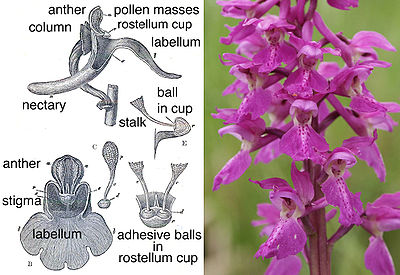
Orchids are plants that belong to the family Orchidaceae, a diverse and widespread group of flowering plants with blooms that are often colourful and fragrant.

Anacamptis pyramidalis, the pyramidal orchid, is a perennial herbaceous plant belonging to the genus Anacamptis of the family Orchidaceae. The scientific name Anacamptis derives from Greek ανακάμτειν 'anakamptein' meaning 'bend forward', while the Latin name pyramidalis refers to the pyramidal form of the inflorescence.

In biology, coevolution occurs when two or more species reciprocally affect each other's evolution through the process of natural selection. The term sometimes is used for two traits in the same species affecting each other's evolution, as well as gene-culture coevolution.

The Sphingidae are a family of moths (Lepidoptera) called sphinx moths, also colloquially known as hawk moths, with many of their caterpillars known as “hornworms”; it includes about 1,450 species. It is best represented in the tropics, but species are found in every region. They are moderate to large in size and are distinguished among moths for their agile and sustained flying ability, similar enough to that of hummingbirds as to be reliably mistaken for them. Their narrow wings and streamlined abdomens are adaptations for rapid flight. The family was named by French zoologist Pierre André Latreille in 1802.
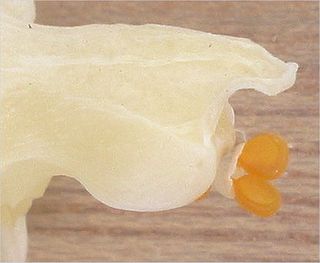
A pollinium is a coherent mass of pollen grains in a plant that are the product of only one anther, but are transferred, during pollination, as a single unit. This is regularly seen in plants such as orchids and many species of milkweeds (Asclepiadoideae). Usage of the term differs: in some orchids two masses of pollen are well attached to one another, but in other orchids there are two halves each of which is sometimes referred to as a pollinium.

Catasetum, abbreviated as Ctsm. in horticultural trade, is a genus of showy epiphytic Orchids, family Orchidaceae, subfamily Epidendroideae, tribe Cymbidieae, subtribe Catasetinae, with 166 species, many of which are highly prized in horticulture.
Between 1860 and 1868, the life and work of Charles Darwinfrom Orchids to Variation continued with research and experimentation on evolution, carrying out tedious work to provide evidence of the extent of natural variation enabling artificial selection. He was repeatedly held up by his illness, and continued to find relaxation and interest in the study of plants. His studies of insect pollination led to publication of his book Fertilisation of Orchids as his first detailed demonstration of the power of natural selection, explaining the complex ecological relationships and making testable predictions. As his health declined, he lay on his sickbed in a room filled with inventive experiments to trace the movements of climbing plants.

Chiloglottis, commonly known as wasp orchids, ant orchids or bird orchids, is a genus of about 25 species of flowering plants in the orchid family, Orchidaceae and is found in eastern Australia and New Zealand. Wasp orchids are terrestrial herbs which grow in colonies of genetically identical plants. They usually have two leaves at the base of the plant and a single resupinate ("upside-down") flower. The labellum is more or less diamond-shaped and has calli resembling the body of a wingless female wasp.

This is a list of the writings of Charles Darwin.

Edmond Albius was a horticulturalist from Réunion. Born into slavery, Albius became an important figure in the cultivation of vanilla. At the age of 12, he invented a technique for pollinating vanilla orchids quickly and profitably. Albius's technique revolutionized the cultivation of vanilla and made it possible to profitably grow Vanilla planifolia away from its native habitat.
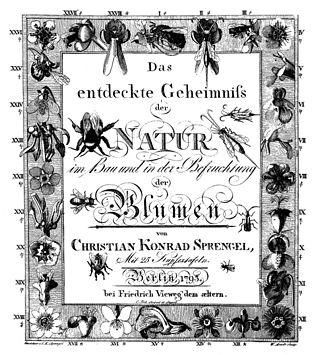
Christian Konrad Sprengel was a German naturalist, theologist, and teacher. He is most famous for his research on plant sexuality. Sprengel was the first to recognize that the function of flowers was to attract insects, and that nature favoured cross-pollination. Along with the work of Joseph Gottlieb Kölreuter he set the foundations for the modern study of floral biology and anthecology, but his work was not widely recognized until Charles Darwin examined and confirmed several of his observations almost 50 years later; see Fertilisation of Orchids (1862).

Angraecum sesquipedale, also known as Darwin's orchid, Christmas orchid, Star of Bethlehem orchid, and king of the angraecums, is an epiphytic orchid in the genus Angraecum endemic to Madagascar. The orchid was first discovered by the French botanist Louis-Marie Aubert du Petit-Thouars in 1798, but was not described until 1822. It is noteworthy for its long spur and its association with the naturalist Charles Darwin, who surmised that the flower was pollinated by a then undiscovered moth with a proboscis whose length was unprecedented at the time. Darwin's prediction went unverified for 21 years after his death, until just such a moth was discovered and his conjecture vindicated. The story of its postulated pollinator has come to be seen as one of the celebrated predictions of the theory of evolution.
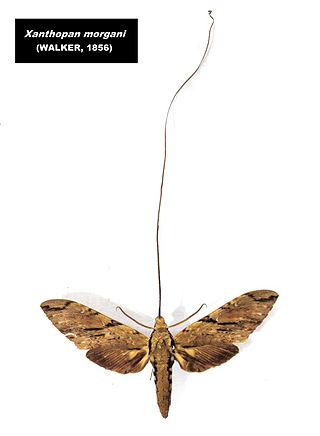
Xanthopan is a monotypic genus of sphinx moth, with Xanthopan morganii, commonly called Morgan's sphinx moth, as its sole species. It is a very large sphinx moth from Southern Africa and Madagascar. Little is known about its biology, though the adults have been found to visit orchids and are one of the main pollinators of several of the Madagascar endemic baobab (Adansonia) species, Adansonia perrieri or Perrier's baobab.
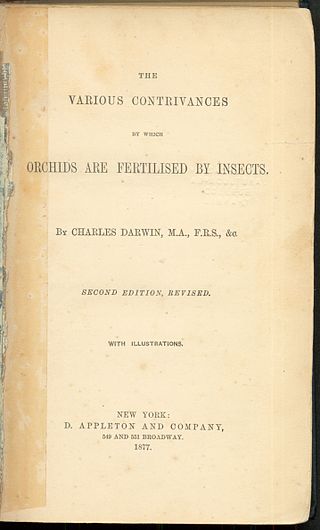
Fertilisation of Orchids is a book by English naturalist Charles Darwin published on 15 May 1862 under the full explanatory title On the Various Contrivances by Which British and Foreign Orchids Are Fertilised by Insects, and On the Good Effects of Intercrossing. Darwin's previous book, On the Origin of Species, had briefly mentioned evolutionary interactions between insects and the plants they fertilised, and this new idea was explored in detail. Field studies and practical scientific investigations that were initially a recreation for Darwin—a relief from the drudgery of writing—developed into enjoyable and challenging experiments. Aided in his work by his family, friends, and a wide circle of correspondents across Britain and worldwide, Darwin tapped into the contemporary vogue for growing exotic orchids.

Catasetum fimbriatum, the fringed catasetum, is a member of the orchid family of flowering plants and lives in a warm tropical environment. This plant uses a fascinating strategy to spread its pollen to other flowers via insects, primarily bees. When a pollinator lands on male flowers of C. fimbriatum and stimulates them, pollen is planted onto the back of the pollinator. This assures their gametes will be spread to other flowers the bee visits of the same species.

Das entdeckte Geheimnis der Natur im Bau und in der Befruchtung der Blumen by Christian Konrad Sprengel was published in 1793, but received little acclaim during the author's lifetime. Sprengel's ideas were rejected by other naturalists when it was published, but the importance of this work was duly appreciated by Charles Darwin some sixty years later. Darwin's use of Sprengel's ideas and reference to this book in the seminal work on the Fertilisation of Orchids established Sprengel's book as one of the most important works in the fields of floral biology and pollination ecology and its author as a founding father of these fields.
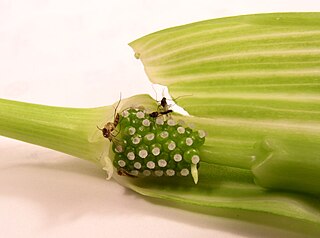
Pollination traps or trap-flowers are plant flower structures that aid the trapping of insects, mainly flies, so as to enhance their effectiveness in pollination. The structures of pollination traps can include deep tubular corollas with downward pointing hairs, slippery surfaces, adhesive liquid, attractants, flower closing and other mechanisms.
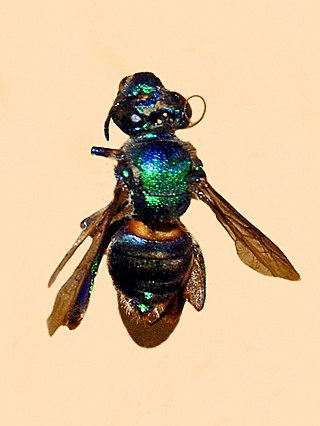
Euglossa cordata is a primitively eusocial orchid bee of the American tropics. The species is known for its green body color and ability to fly distances of over 50 km. Males mostly disperse and leave their home nests, while females have been observed to possess philopatric behavior. Because of this, sightings are rare and little is known about the species. However, it has been observed that adults who pollinate certain species of orchids will become intoxicated during the pollination.
John Rogers (1807–1867) was an English barrister, known as a naturalist particularly interested in orchids, and gardener.

The pollination of orchids is a complex chapter in the biology of this family of plants that are distinguished by the complexity of their flowers and by intricate ecological interactions with their pollinator agents. It has captured the attention of numerous scientists over time, including Charles Darwin, father of the theory of evolution by natural selection. Darwin published in 1862 the first observations of the fundamental role of insects in orchid pollination, in his book The Fertilization of Orchids. Darwin stated that the varied stratagems orchids use to attract their pollinators transcend the imagination of any human being.
